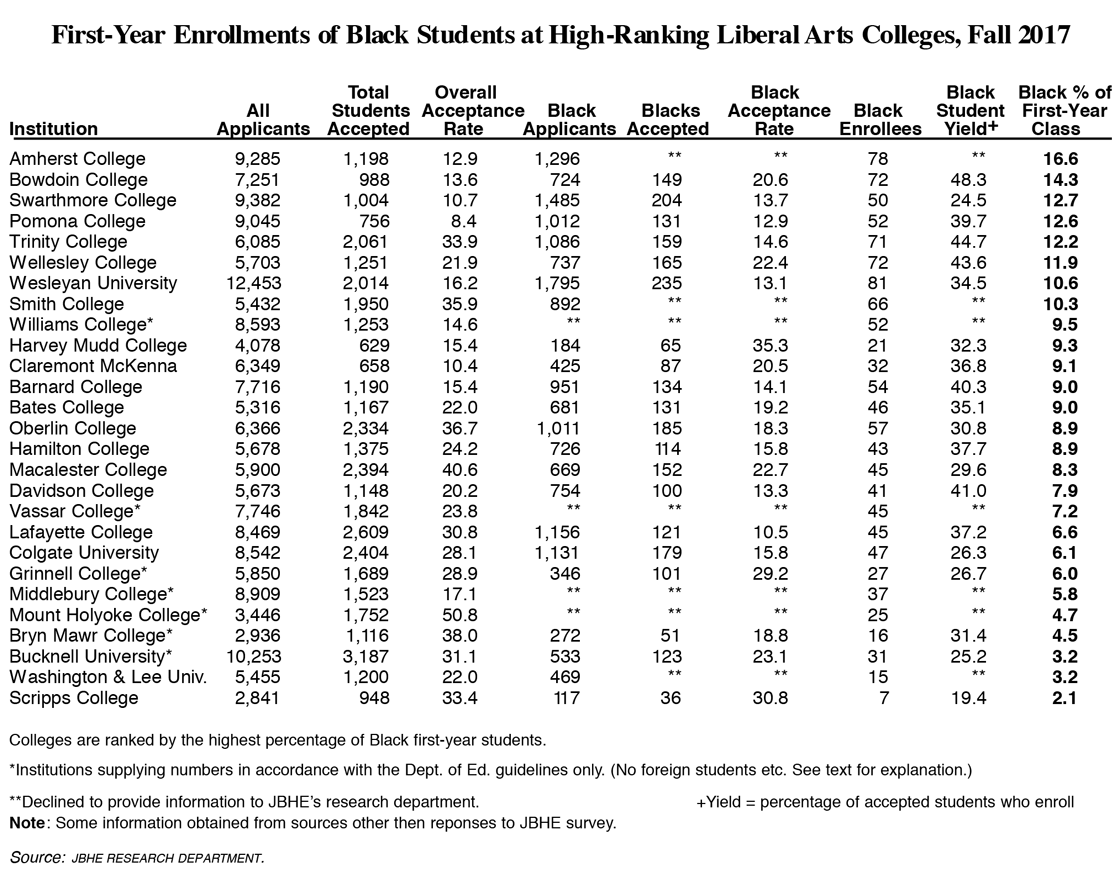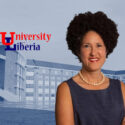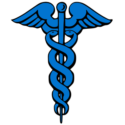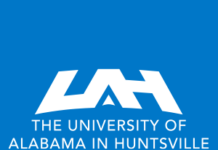![]() For the past 24 years JBHE has collected Black student admissions data from the highest-ranked liberal arts colleges. Over this long period, there have been 10 years when Amherst College in Massachusetts reported the highest percentage of Black first-year students. On six occasions, Wesleyan University in Middletown, Connecticut, had enrolled the highest percentage of Black first-year students.
For the past 24 years JBHE has collected Black student admissions data from the highest-ranked liberal arts colleges. Over this long period, there have been 10 years when Amherst College in Massachusetts reported the highest percentage of Black first-year students. On six occasions, Wesleyan University in Middletown, Connecticut, had enrolled the highest percentage of Black first-year students.
Last year, for the first time in the history of our survey, Pomona College in Claremont, California, had the highest percentage of Black students in the entering classes at the nation’s leading liberal arts colleges. There were 65 Black first-year students at Pomona College last year. They make up 15.8 percent of the entering class.
Last year, Amherst College finished a very close second in our survey. This broke Amherst’s string of first places finishes in the three previous JBHE surveys. But now Amherst is back on top. There are 78 Black first-year students at Amherst. They make up 16.6 percent of the entering class. Two years ago, there were 87 Black first-year students at Amherst. They made up a whopping 18.2 percent of the first-year class. This was largest percentage of Black first-year students at any of the high-ranking liberal arts colleges in the 24 years that JBHE has conducted this survey.

Bowdoin College in Brunswick, Maine, ranks second in this year’s survey with an entering class that is 14.3 percent Black. A Bowdoin spokesperson told JBHE that “diverse perspectives, backgrounds, and experiences are essential components of a liberal arts education. So, we have broadened our recruitment efforts to different areas of the country. We have also eliminated a barrier for some students by doing away with our application fee for those applying for financial aid and for first-generation college students.”
Swarthmore College in Pennsylvania ranks third in our survey this year. This is the same position it held last year. There are 50 Black first-year students at the college this year, making up 12.7 percent of the entering class. Two years ago, Swarthmore ranked 14th in our survey of leading liberal arts colleges in the percentage of Black students in the entering class. That year, Blacks were 8.1 percent of the first-year class.
Pomona College drops from first to fourth place this year. There are 52 Black students in the entering class. They make up 12.6 percent of all first-year students. Just four years ago, Blacks were only 8.8 percent of the first-year class at Pomona.
Trinity College in Hartford, Connecticut ranks fourth in this year’s survey with an entering class that is 12.2 percent Black.
Wellesley College in Massachusetts ranks fifth in our survey with an entering class that is 11.9 percent Black. Last year, Wellesley ranked eighth with an entering class than was 9.3 percent Black
Wesleyan University, which as stated, has led our rankings on six occasions including five years ago, ranks seventh in this year’s survey. Blacks are 10.6 percent of the first-year class at Wesleyan. Five years ago when Wesleyan led the rankings, Blacks were 11.3 percent of the entering class.
Smith College ranks eighth in our survey with an entering class that is 10.3 percent Black. Smith was fifth in last year’s survey with an entering class that was 11.2 percent Black.
Williams College has been a consistent performer and this year is no exception. There are 52 African American first-year students making up 9.5 percent of the entering class, placing Williams in ninth place in our survey. Two year ago, Williams ranked third with an entering class that was 13.1 percent Black.
Harvey Mudd College in Claremont, California, bills itself as the nation’s top liberal arts college of engineering, science and mathematics. It holds the tenth position in our survey with an entering class that is 9.3 percent Black. In 2009, Harvey Mudd College ranked last in our survey in the Black percentage of first-year students. That year there were only three black students in the entering class. They made up just 1.4 percent of all entering students.
Here is one very encouraging statistic: In 2009, only three of the nation’s high-ranking liberal arts colleges had entering classes that were at least 10 percent Black. This year there are eight. Another five major liberal arts colleges this year have entering classes that are at least 9 percent Black.
A Note on Methodology
Before we continue with the results, it is important to mention how the U.S. Department of Education collects data on the race of undergraduates. Before a change was made several years ago, students who reported more than one race (including African American) were included in the figures for Black students. This is no longer the case. Thus, students who self-identify as biracial or multiracial with some level of African heritage are no longer classified as Black by the Department of Education.
JBHE surveys have always asked respondents to include all students who self-identify as having African American or African heritage including those who are actually from Africa. JBHE has always maintained that biracial, multiracial, and Black students from Africa add to the diversity of a college campus. And including these students in our figures offers college-bound Black students a better idea of what they can expect at a given college or university. In order that we can compare our current data to past JBHE surveys we have continued to asked colleges and universities to include all students who identify themselves as having African American or African heritage.
Some of our responding liberal arts chose to report results that correspond with official Department of Education figures. They are indicated on the main table with an asterisk. It should be noted that if biracial, multiracial, and Black foreign students were included in the Black percentage of students in the first-year classes at these institutions, the overall percentage of Black students would undoubtedly be higher.
Liberal Arts Colleges: Short-Term Gainers

Now we turn to a comparison of this year’s results with the data from last year. For the 23 colleges for which we have data in both 2016 and 2017, 11 colleges posted gains over last year in Black enrollments. Twelve colleges showed a decline. Two years ago, 18 liberal arts college reported an increase in the number of entering Black students from the previous year and only six posted declines.
Macalester College in St. Paul, Minnesota, had the largest percentage increase in Black first-year students. There are 45 Black first year students at the college this year compared to 30 a year ago. The Black percentage of first year students increased from 5.9 percent in 2015 to 8.3 percent this year. Two years ago, Blacks were only 3.4 percent of the entering class at Macalester.
Hamilton College, Middlebury College, and Claremont McKenna College, all posted gains of at least 40 percent in the number of Black first-year students. Wellesley College, Grinnell College and Barnard College all posted gains of at least 20 percent.
Leading liberal arts colleges that showed significant declines of at least 20 percent in Black first-year students were Pomona College, Colgate University, Lafayette College, Bryn Mawr College, and Mount Holyoke College.
Black Acceptance Rates at Liberal Arts Colleges
Acceptance rate data is a closely guarded secret at many high-ranking universities. But most of the nation’s leading liberal arts colleges are willing to disclose this information.
Five years ago, for the first time in the history of the JBHE survey of liberal arts colleges, more responding colleges had a lower acceptance rate for Black students than their overall acceptance rate compared to the number of colleges that had a Black acceptance rate that was higher than their overall rate. This was true again in 2013, 2014, 2015, and 2016. This makes the sixth year in a row when more liberals arts college showed a lower acceptance rate for Black students than the acceptance rate for students overall. In fact, the trend has accelerated. This year, only seven high-ranking liberal arts colleges had a Black student acceptance rate that was higher than for the overall applicant pool. Three years ago there were nine. Many of these liberal arts colleges that had a high Black student acceptance rate were among the colleges that had the highest percentage of Blacks in their entering class.
While no firm conclusions can be made, the fact that for the past six years there are now more colleges with overall acceptance rates that are higher than Black acceptance rates, causes one to wonder if there has been some curtailment in colleges’ consideration of race in admissions decisions.
At the liberal arts colleges where the Black student acceptance rate was lower than the rate for all students, the differences were substantial at some institutions. For example, at Macalester College in Minnesota, 40.6 percent of all students were accepted but only 22.7 percent of Black students were admitted. At Oberlin College, 36.7 percent of all applicants were accepted for admission but only 18.3 percent of Black applicants were accepted.
In contrast, Harvey Mudd College accepted only 15.4 percent of all applicants. But the acceptance rate for Black applicants was 35.3 percent. At Claremont McKenna College, the Black student acceptance rate of 20.5 percent was nearly double the overall acceptance rate of 10.4 percent.
Student yield is calculated by seeing what percentage of accepted students decided to enroll. Among the leading liberal arts colleges who supplied this information to JBHE, the highest Black student yield was at Bowdoin College. There 48.3 percent of accepted Black students decided to enroll. Trinity College ranked second with a Black student yield of 44.7 percent. At Wellesley College, 43.6 percent of all accepted Black students decided to enroll. Davidson College and Barnard College were the only other leading liberal arts colleges that had a Black student yield of more than 40 percent.










